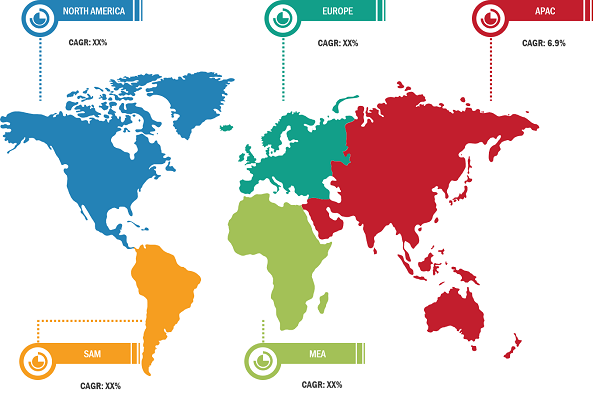Rise in Demand for Natural Gas
According to our latest market study on "Gas Pipeline Infrastructure Market Forecast to 2030 — Global Analysis — by Operation, Equipment, and Application," the gas pipeline infrastructure market size was valued at US$ 31,782.8 million in 2022 and is projected to reach US$ 40,703.5 million by 2030; it is expected to register a CAGR of 3.1% from 2022 to 2030.
The gas pipeline infrastructure market study is a dynamic sector influenced by various industry drivers, restraints, opportunities, and trends. One of the key drivers propelling the gas pipeline infrastructure market growth is the increasing global demand for energy, particularly from emerging economies. As offshore exploration and production activities expand to meet this demand, the need for reliable and efficient piping systems escalates. However, the industry faces restraints such as the high costs associated with offshore projects. The capital-intensive nature of exploration and extraction in deep-sea environments poses financial challenges, restraining the market growth. Environmental concerns and stringent regulations also act as restraints, pushing companies to invest in sustainable and eco-friendly solutions.
Gas Pipeline Infrastructure Market Share – by Region, 2023
Gas Pipeline Infrastructure Market Size and Forecast (2020–2030), Global and Regional Share, Trend, and Growth Opportunity Analysis Report Coverage: By Operation (Transmission and Distribution), Equipment (Pipeline, Compressor Station, Metering Skids, and Others), and Application (Onshore and Offshore) and Geography
Gas Pipeline Infrastructure Market Overview by 2030
Download Free Sample
Source: The Insight Partners Analysis
The increasing demand for natural gas for power generation, heating, cooking, and transportation is boosting the demand for natural gas. The versatile application of natural gas leads to a growing share of natural gas within energy portfolios. Natural gas is one of the foremost energy sources as it is the least polluting of the fossil fuels. Natural gas is key for fabricating fertilizers, chemicals, and hydrogen. Natural gas is also preferred as an alternative for many household applications such as heating or water heating. Gas-powered models for air conditioning also require natural gas for operation.
Further, the usage of natural gas is considered important in the commercial sector. Natural gas is employed in manufacturing paper, bricks, glass, steel, and iron as a cheap alternative to other gases. The increasing preference for high-capacity and cheap energy resources is boosting the application of natural gas. The augmented demand for natural gas requires adequate accumulation of natural gas, which drives the need for proper gas pipeline infrastructure. For instance, in September 2023, the consumption of natural gas was 5,254 million metric standard cubic meters in India. The country’s natural gas demand is anticipated to grow by over 8% by 2026, owing to developments in the fertilizer sector.
In addition, natural gas production and demand are anticipated to rise in the US between 2023 and 2024, as per the US Energy Information Administration. Natural gas production is anticipated to reach 103.68 billion cubic feet per day in 2023 and 105.12 billion cubic feet per day by 2024, rising from 99.60 billion cubic feet per day in 2022. Thus, the rise in demand for natural gas drives the gas pipeline infrastructure market.
The gas pipeline infrastructure market analysis is categorized into five major regions—North America, Europe, Asia Pacific, Middle East & Africa (MEA), and South America (SAM). In 2022, Europe led the gas pipeline infrastructure market.
The global gas pipeline infrastructure market industry forms a vital and intricate network that traverses continents, seamlessly connecting gas production hubs to diverse consumer markets. North America recorded the largest global gas pipeline infrastructure market share. This is owing to the rise in demand for natural gas with an increase in shale gas exploration and production activities in the US. Per the U.S. Energy Information Administration, the natural gas pipeline network is a widely integrated network that transports natural gas across the US. The pipeline network includes approximately 3 million miles of mains and other pipelines connecting natural gas production areas and storage facilities to consumers. In 2021, this natural gas transmission network delivered approximately 27.6 trillion cubic feet (Tcf) of natural gas to ~77.7 million consumers. North America showcases a robust pipeline network, interlinking major gas-producing regions such as the Permian Basin and the Marcellus Shale with consumption centers across the US and Canada.
Europe has a sophisticated grid facilitating gas transportation from Russian and North Sea production sites to consumers across the region, exemplified by pipelines such as Nord Stream and the Trans-European Gas Pipeline (TENP). In Asia, rapid growth is witnessed in gas pipeline development to meet escalating demand, with pipelines such as the Central Asia-China Gas Pipeline linking Russian and Central Asian sources to markets in China. The Middle East features an intricate web of pipelines connecting gas-rich countries, including Qatar and Iran, to regional and international consumers, with projects such as the Arab Gas Pipeline. Africa, South America, and Oceania are witnessing evolving gas pipeline landscapes, connecting production to end user demand in regions with burgeoning energy needs. Australia, a significant LNG exporter, develops pipelines to transport gas from inland basins to coastal export terminals. This global network underscores the pivotal role of gas pipeline infrastructure in facilitating the transportation of natural gas, bridging the gap between diverse production sites and the dynamic energy demands of an interconnected world. Geopolitical considerations, regulatory frameworks, and technological innovations are anticipated to continue to shape the evolution of this critical energy infrastructure in the upcoming years.
Enbridge Inc, Kinder Morgan Inc, TC Energy Corporation, Pembina Pipeline Corporation, Sinopec Group, Pipeline Infrastructure Limited, Enagas S.A., Berkshire Hathaway, Saipem, and Bechtel Corporation are among the key gas pipeline infrastructure market players profiled during this study. In addition, several other important gas pipeline infrastructure market players have been studied and analyzed during the study to get a holistic view of the gas pipeline infrastructure market analysis and management and its ecosystem.
Contact Us
Phone: +1-646-491-9876
Email Id: sales@theinsightpartners.com